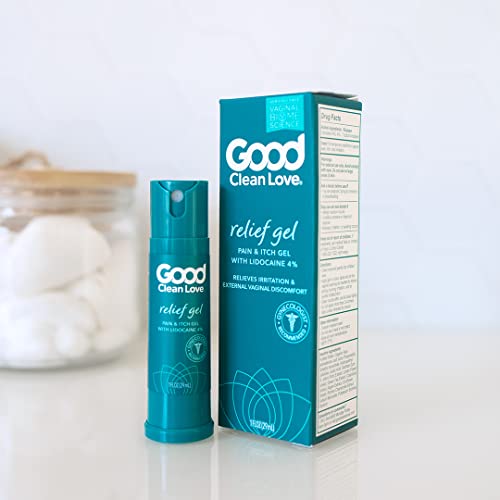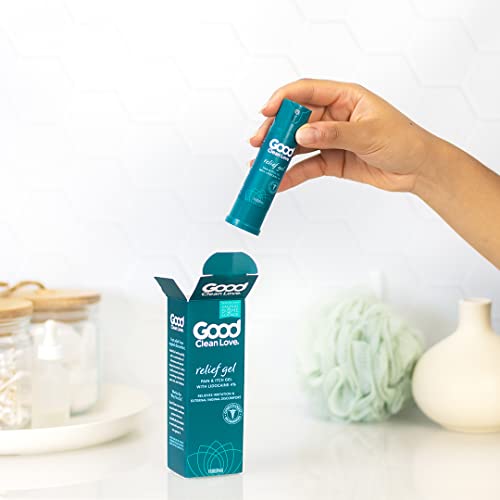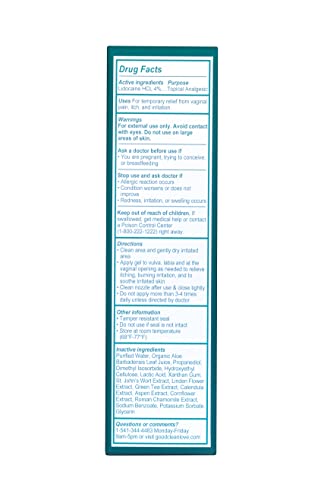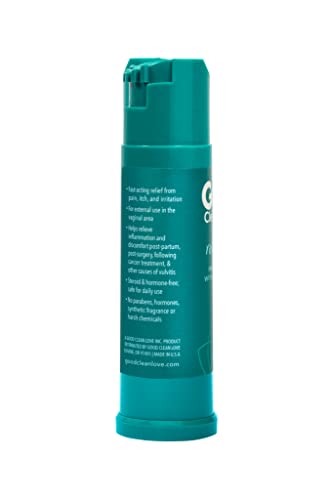






Good Clean Love Feminine Care Set - Fast-Acting Pain Relief, Botanical Ingredients - 1 Oz


Lactic Acid, L
High RiskLactic acid is an organic acid commonly used in cosmetics and skincare products as an exfoliant and pH regulator. It helps in improving skin texture and hydration by promoting the shedding of dead skin cells and enhancing moisture retention.
Sustai Insights
Lactic acid offers functional benefits as an effective exfoliant and moisturizer, contributing to improved skin appearance. However, it poses potential risks, including skin irritation and enhanced absorption, which may lead to adverse effects. Regulatory bodies have noted use restrictions due to these concerns. Overall, the ingredient is considered high risk, necessitating cautious usage, particularly for sensitive skin. Alternatives like glycolic acid may provide similar benefits with potentially lower irritation.
Sodium Benzoate
Medium RiskSodium benzoate is a preservative commonly used in food and cosmetic products to prevent microbial growth and extend shelf life. It is derived from benzoic acid and is effective at low concentrations, often used in acidic environments like beverages and condiments.
Sustai Insights
Sodium benzoate serves effectively as a preservative, contributing to product stability and safety. It is generally recognized as safe with low concerns for carcinogenicity, allergies, and reproductive toxicity, though it faces moderate use restrictions in some regions. Environmental risks include its potential as a pollutant, but it does not bioaccumulate significantly. Regulatory bodies have issued advisories regarding its concentration in products. Overall, the risk level is assessed as medium, with safe usage practices recommended. Alternatives such as potassium sorbate may provide similar benefits with potentially lower restrictions.
Potassium Sorbate
Medium RiskPotassium sorbate is a potassium salt of sorbic acid, primarily used as a preservative in food and cosmetic products. It inhibits the growth of molds, yeast, and some bacteria, extending the shelf life of products. It is commonly found in various formulations due to its effectiveness and low toxicity.
Sustai Insights
Potassium sorbate serves as an effective preservative, preventing microbial growth in food and cosmetic products, which is vital for safety and longevity. Although it has a low risk of carcinogenicity and developmental toxicity, there is a moderate concern regarding allergies and immunotoxicity. Environmentally, it poses minimal risks as it is not significantly bioaccumulative. Regulatory agencies have verified its use, although some products may face restrictions. Overall, it is assessed as a medium risk ingredient, with safe usage practices recommended, and alternatives such as natural preservatives could be considered.
Xanthan Gum
Low RiskXanthan gum is a polysaccharide, a sugar-based compound produced by the fermentation of glucose or sucrose. It is commonly used as a thickening agent and stabilizer in various food and cosmetic products due to its ability to improve texture and prevent ingredient separation.
Sustai Insights
Xanthan gum serves effectively as a thickener and stabilizer, enhancing product texture and consistency. It is biodegradable and typically derived from renewable sources, supporting sustainability efforts. Health risks are minimal, with low concerns regarding carcinogenicity, allergies, and reproductive toxicity. Environmental impact is similarly low, posing no significant hazards. Regulatory agencies, including the FDA, regard it as safe for use, with no significant restrictions. Overall, xanthan gum is assessed as low risk, making it a suitable ingredient in formulations.
Tilia Cordata (Linden) Flower Extract
Low RiskTilia cordata (linden) flower extract is an extract derived from the flowers of the linden tree, primarily used for its aromatic and potential soothing properties in cosmetic formulations.
Sustai Insights
Tilia cordata flower extract offers functional benefits, including its role as a skin-soothing agent and fragrance component. It is considered low risk for health concerns, showing minimal allergenic potential and no significant toxicity. Environmentally, it is not associated with bioaccumulation or pollution. Regulatory assessments indicate no current restrictions. Overall, the ingredient presents a low risk profile, making it a viable option in cosmetic products.
Hypericum Perforatum (St. John's Wort) Extract
Low RiskHypericum perforatum extract, commonly known as St. John's Wort extract, is derived from the flowering tops of the Hypericum perforatum plant. It is primarily utilized in cosmetic formulations for its potential skin-soothing properties and to enhance skin absorption of other ingredients.
Sustai Insights
Hypericum perforatum extract may provide functional benefits such as skin soothing and enhanced absorption in formulations. It is considered low risk for common health concerns, including carcinogenicity, allergenic potential, and reproductive toxicity. Environmental risks are minimal, and the ingredient is not currently restricted by regulatory bodies. Overall, it presents a low risk for use in cosmetics, making it a viable option in formulations, although alternatives should be considered for specific applications.
Dimethyl Isosorbide
Low RiskDimethyl isosorbide is a dimethyl ether of isosorbide, commonly used as a solvent and penetration enhancer in cosmetic and personal care formulations. It helps in improving the solubility of active ingredients and enhances their delivery into the skin.
Sustai Insights
Dimethyl isosorbide serves effectively as a solvent and penetration enhancer, promoting the absorption of active ingredients in formulations. It is generally regarded as having low health risks, with minimal concerns related to carcinogenicity, allergies, and reproductive toxicity. Environmentally, it poses low risk, with no bioaccumulation potential noted. Regulatory bodies do not currently impose restrictions on its use. Safe usage practices should be followed, and while there are less harmful alternatives, the overall risk associated with dimethyl isosorbide is assessed as low.
Vegetarian Glycerin
Low RiskVegetarian glycerin, also known as glycerol, is a colorless, odorless, and viscous liquid derived from plant sources. It is primarily used as a humectant, solvent, and emollient in various personal care products, helping to retain moisture and improve texture.
Sustai Insights
Vegetarian glycerin offers functional benefits as an effective humectant, promoting hydration and skin smoothness. It is biodegradable and typically sustainably sourced. Health risks associated with glycerin are low, with no significant concerns for carcinogenicity, allergens, or reproductive toxicity. Environmental risks are minimal, and it is not subject to major regulatory warnings. Overall, the risk level for this ingredient is low, making it a safe choice in formulations. Safe usage practices include ensuring proper concentrations in products, and alternatives such as propylene glycol exist but may have differing properties.
Centaurea Cyanus (Cornflower) Flower Extract
Low RiskCentaurea cyanus (cornflower) flower extract is derived from the flowers of the cornflower plant. It is commonly used in cosmetic formulations for its potential soothing and anti-inflammatory properties. The extract is primarily utilized in skincare and personal care products, contributing to their overall texture and effectiveness.
Sustai Insights
Centaurea cyanus flower extract offers functional benefits such as soothing properties, which can enhance product efficacy in skincare. It is sustainably sourced and biodegradable, contributing to eco-friendly formulations. Health risks are low, with minimal concerns regarding carcinogenicity, allergies, or reproductive toxicity. Environmental impact is also low, as it does not contribute significantly to pollution or bioaccumulation. Regulatory status indicates no current restrictions. Overall, the ingredient presents a low risk, making it a suitable choice in formulations.
Propanediol
Low RiskPropanediol is a glycol compound commonly used in cosmetic and personal care products as a solvent, humectant, and skin-conditioning agent. It serves to enhance the texture and moisture retention of formulations, contributing to overall product efficacy.
Sustai Insights
Propanediol offers functional benefits such as effective moisture retention and improved product application. It is considered low-risk in terms of health concerns, with minimal associations with carcinogenicity, allergies, or reproductive toxicity. Environmentally, it has low pollutant potential and is not bioaccumulative. Regulatory bodies have not placed restrictions on its use. Despite concerns regarding enhanced skin absorption and potential endocrine disruption, the overall assessment indicates low risk. Safe usage practices should be followed, and alternatives like glycerin or other plant-based humectants can be considered.
Camellia Oleifera (Tea Oil Camellia) Seed Extract
Low RiskCamellia oleifera (tea oil camellia) seed extract is derived from the seeds of the Camellia oleifera plant. It is primarily used in cosmetic formulations for its potential moisturizing and skin-conditioning properties, contributing to the overall texture and feel of the product.
Sustai Insights
This ingredient provides functional benefits as a skin moisturizer and conditioner, often sourced sustainably. Health risks are minimal, with low concerns regarding carcinogenicity, allergies, and reproductive toxicity. Environmental risks are also low, with no significant pollutant or bioaccumulation potential identified. Regulatory assessments indicate no active restrictions. Overall, the risk level for this ingredient is considered low. Safe usage practices include ensuring appropriate formulation concentrations, and alternatives may include other plant-derived extracts with similar benefits.
Calendula Officinalis (Pot Marigold) Flower Extract
Low RiskExtract of the Calendula (Calendula officinalis) flower, commonly known as pot marigold, is utilized in cosmetic formulations for its soothing and anti-inflammatory properties. It is often included in creams, lotions, and ointments to promote skin health and healing.
Sustai Insights
Calendula officinalis flower extract offers functional benefits such as skin soothing and anti-inflammatory effects, making it valuable in topical applications. It is considered low risk for health impacts, with minimal concerns regarding carcinogenicity, allergies, or reproductive toxicity. Environmentally, it presents low pollution potential and is not bioaccumulative. Regulatory bodies have not imposed significant restrictions. Safe usage practices should be followed, and while alternatives exist, this extract is generally regarded as a low-risk option for cosmetic use.
Hydroxyethylcellulose
Low RiskHydroxyethylcellulose is a modified cellulose polymer used primarily as a thickening agent and stabilizer in various cosmetic and personal care products. It is soluble in water and helps to improve the texture and viscosity of formulations, enhancing their usability and performance.
Sustai Insights
Hydroxyethylcellulose offers functional benefits such as effective thickening and stabilization in formulations, contributing to product texture. It is generally considered low-risk in terms of health, with minimal concerns regarding carcinogenicity, allergens, or reproductive toxicity. Environmentally, it poses low risks and is not known to be bioaccumulative. Regulatory bodies have not imposed significant restrictions on its use. Safe practices include adhering to recommended concentrations, and while alternatives exist, hydroxyethylcellulose remains a low-risk ingredient overall.
Xanthan Gum
Low RiskXanthan gum is a polysaccharide, a sugar-based compound produced by the fermentation of glucose or sucrose. It is commonly used as a thickening agent and stabilizer in various food and cosmetic products due to its ability to improve texture and prevent ingredient separation.
Sustai Insights
Xanthan gum serves effectively as a thickener and stabilizer, enhancing product texture and consistency. It is biodegradable and typically derived from renewable sources, supporting sustainability efforts. Health risks are minimal, with low concerns regarding carcinogenicity, allergies, and reproductive toxicity. Environmental impact is similarly low, posing no significant hazards. Regulatory agencies, including the FDA, regard it as safe for use, with no significant restrictions. Overall, xanthan gum is assessed as low risk, making it a suitable ingredient in formulations.
Tilia Cordata (Linden) Flower Extract
Low RiskTilia cordata (linden) flower extract is an extract derived from the flowers of the linden tree, primarily used for its aromatic and potential soothing properties in cosmetic formulations.
Sustai Insights
Tilia cordata flower extract offers functional benefits, including its role as a skin-soothing agent and fragrance component. It is considered low risk for health concerns, showing minimal allergenic potential and no significant toxicity. Environmentally, it is not associated with bioaccumulation or pollution. Regulatory assessments indicate no current restrictions. Overall, the ingredient presents a low risk profile, making it a viable option in cosmetic products.
Hypericum Perforatum (St. John's Wort) Extract
Low RiskHypericum perforatum extract, commonly known as St. John's Wort extract, is derived from the flowering tops of the Hypericum perforatum plant. It is primarily utilized in cosmetic formulations for its potential skin-soothing properties and to enhance skin absorption of other ingredients.
Sustai Insights
Hypericum perforatum extract may provide functional benefits such as skin soothing and enhanced absorption in formulations. It is considered low risk for common health concerns, including carcinogenicity, allergenic potential, and reproductive toxicity. Environmental risks are minimal, and the ingredient is not currently restricted by regulatory bodies. Overall, it presents a low risk for use in cosmetics, making it a viable option in formulations, although alternatives should be considered for specific applications.
Dimethyl Isosorbide
Low RiskDimethyl isosorbide is a dimethyl ether of isosorbide, commonly used as a solvent and penetration enhancer in cosmetic and personal care formulations. It helps in improving the solubility of active ingredients and enhances their delivery into the skin.
Sustai Insights
Dimethyl isosorbide serves effectively as a solvent and penetration enhancer, promoting the absorption of active ingredients in formulations. It is generally regarded as having low health risks, with minimal concerns related to carcinogenicity, allergies, and reproductive toxicity. Environmentally, it poses low risk, with no bioaccumulation potential noted. Regulatory bodies do not currently impose restrictions on its use. Safe usage practices should be followed, and while there are less harmful alternatives, the overall risk associated with dimethyl isosorbide is assessed as low.
Sodium Benzoate
Medium RiskSodium benzoate is a preservative commonly used in food and cosmetic products to prevent microbial growth and extend shelf life. It is derived from benzoic acid and is effective at low concentrations, often used in acidic environments like beverages and condiments.
Sustai Insights
Sodium benzoate serves effectively as a preservative, contributing to product stability and safety. It is generally recognized as safe with low concerns for carcinogenicity, allergies, and reproductive toxicity, though it faces moderate use restrictions in some regions. Environmental risks include its potential as a pollutant, but it does not bioaccumulate significantly. Regulatory bodies have issued advisories regarding its concentration in products. Overall, the risk level is assessed as medium, with safe usage practices recommended. Alternatives such as potassium sorbate may provide similar benefits with potentially lower restrictions.
Vegetarian Glycerin
Low RiskVegetarian glycerin, also known as glycerol, is a colorless, odorless, and viscous liquid derived from plant sources. It is primarily used as a humectant, solvent, and emollient in various personal care products, helping to retain moisture and improve texture.
Sustai Insights
Vegetarian glycerin offers functional benefits as an effective humectant, promoting hydration and skin smoothness. It is biodegradable and typically sustainably sourced. Health risks associated with glycerin are low, with no significant concerns for carcinogenicity, allergens, or reproductive toxicity. Environmental risks are minimal, and it is not subject to major regulatory warnings. Overall, the risk level for this ingredient is low, making it a safe choice in formulations. Safe usage practices include ensuring proper concentrations in products, and alternatives such as propylene glycol exist but may have differing properties.
Centaurea Cyanus (Cornflower) Flower Extract
Low RiskCentaurea cyanus (cornflower) flower extract is derived from the flowers of the cornflower plant. It is commonly used in cosmetic formulations for its potential soothing and anti-inflammatory properties. The extract is primarily utilized in skincare and personal care products, contributing to their overall texture and effectiveness.
Sustai Insights
Centaurea cyanus flower extract offers functional benefits such as soothing properties, which can enhance product efficacy in skincare. It is sustainably sourced and biodegradable, contributing to eco-friendly formulations. Health risks are low, with minimal concerns regarding carcinogenicity, allergies, or reproductive toxicity. Environmental impact is also low, as it does not contribute significantly to pollution or bioaccumulation. Regulatory status indicates no current restrictions. Overall, the ingredient presents a low risk, making it a suitable choice in formulations.
Lactic Acid, L
High RiskLactic acid is an organic acid commonly used in cosmetics and skincare products as an exfoliant and pH regulator. It helps in improving skin texture and hydration by promoting the shedding of dead skin cells and enhancing moisture retention.
Sustai Insights
Lactic acid offers functional benefits as an effective exfoliant and moisturizer, contributing to improved skin appearance. However, it poses potential risks, including skin irritation and enhanced absorption, which may lead to adverse effects. Regulatory bodies have noted use restrictions due to these concerns. Overall, the ingredient is considered high risk, necessitating cautious usage, particularly for sensitive skin. Alternatives like glycolic acid may provide similar benefits with potentially lower irritation.
Propanediol
Low RiskPropanediol is a glycol compound commonly used in cosmetic and personal care products as a solvent, humectant, and skin-conditioning agent. It serves to enhance the texture and moisture retention of formulations, contributing to overall product efficacy.
Sustai Insights
Propanediol offers functional benefits such as effective moisture retention and improved product application. It is considered low-risk in terms of health concerns, with minimal associations with carcinogenicity, allergies, or reproductive toxicity. Environmentally, it has low pollutant potential and is not bioaccumulative. Regulatory bodies have not placed restrictions on its use. Despite concerns regarding enhanced skin absorption and potential endocrine disruption, the overall assessment indicates low risk. Safe usage practices should be followed, and alternatives like glycerin or other plant-based humectants can be considered.
Camellia Oleifera (Tea Oil Camellia) Seed Extract
Low RiskCamellia oleifera (tea oil camellia) seed extract is derived from the seeds of the Camellia oleifera plant. It is primarily used in cosmetic formulations for its potential moisturizing and skin-conditioning properties, contributing to the overall texture and feel of the product.
Sustai Insights
This ingredient provides functional benefits as a skin moisturizer and conditioner, often sourced sustainably. Health risks are minimal, with low concerns regarding carcinogenicity, allergies, and reproductive toxicity. Environmental risks are also low, with no significant pollutant or bioaccumulation potential identified. Regulatory assessments indicate no active restrictions. Overall, the risk level for this ingredient is considered low. Safe usage practices include ensuring appropriate formulation concentrations, and alternatives may include other plant-derived extracts with similar benefits.
Calendula Officinalis (Pot Marigold) Flower Extract
Low RiskExtract of the Calendula (Calendula officinalis) flower, commonly known as pot marigold, is utilized in cosmetic formulations for its soothing and anti-inflammatory properties. It is often included in creams, lotions, and ointments to promote skin health and healing.
Sustai Insights
Calendula officinalis flower extract offers functional benefits such as skin soothing and anti-inflammatory effects, making it valuable in topical applications. It is considered low risk for health impacts, with minimal concerns regarding carcinogenicity, allergies, or reproductive toxicity. Environmentally, it presents low pollution potential and is not bioaccumulative. Regulatory bodies have not imposed significant restrictions. Safe usage practices should be followed, and while alternatives exist, this extract is generally regarded as a low-risk option for cosmetic use.
Hydroxyethylcellulose
Low RiskHydroxyethylcellulose is a modified cellulose polymer used primarily as a thickening agent and stabilizer in various cosmetic and personal care products. It is soluble in water and helps to improve the texture and viscosity of formulations, enhancing their usability and performance.
Sustai Insights
Hydroxyethylcellulose offers functional benefits such as effective thickening and stabilization in formulations, contributing to product texture. It is generally considered low-risk in terms of health, with minimal concerns regarding carcinogenicity, allergens, or reproductive toxicity. Environmentally, it poses low risks and is not known to be bioaccumulative. Regulatory bodies have not imposed significant restrictions on its use. Safe practices include adhering to recommended concentrations, and while alternatives exist, hydroxyethylcellulose remains a low-risk ingredient overall.
Potassium Sorbate
Medium RiskPotassium sorbate is a potassium salt of sorbic acid, primarily used as a preservative in food and cosmetic products. It inhibits the growth of molds, yeast, and some bacteria, extending the shelf life of products. It is commonly found in various formulations due to its effectiveness and low toxicity.
Sustai Insights
Potassium sorbate serves as an effective preservative, preventing microbial growth in food and cosmetic products, which is vital for safety and longevity. Although it has a low risk of carcinogenicity and developmental toxicity, there is a moderate concern regarding allergies and immunotoxicity. Environmentally, it poses minimal risks as it is not significantly bioaccumulative. Regulatory agencies have verified its use, although some products may face restrictions. Overall, it is assessed as a medium risk ingredient, with safe usage practices recommended, and alternatives such as natural preservatives could be considered.
Experience soothing relief with the Good Clean Love Vaginal Pain & Itch Relief Gel, formulated with 4% lidocaine. Designed for fast-acting relief from pain, itch, and irritation, this gel promotes vaginal health, making it ideal for postpartum or post-surgery support.
- Effective Pain Relief: This 4% lidocaine solution reduces discomfort by blocking nerve sensitivity, providing long-lasting relief with just a small amount.
- Natural Ingredients: Enriched with botanicals like linden flower, green tea, and chamomile in a base of organic aloe, ensuring gentle care for sensitive areas.
- Hormone-Free Formula: This gel is free from steroids and hormones, making it a safe choice for personal care without unwanted additives.
- Versatile Use: Ideal as a lubricant, wash, or moisturizer, this gel adapts to your needs, supporting your intimate health.
- Commitment to Clean: 100% paraben-free and free of artificial fragrances, this product aligns with your values for sustainability and health-conscious living.
Subscribe & Save with Sustai
- Best Price Guarantee: Always enjoy the lowest prices on sustainable home essentials.
- No Surprises: We’ll notify you before shipping. No hidden fees, ever.
- You’re in Charge: Change, pause, or cancel your subscription anytime with ease.
- Eco-Friendly Deliveries: Our grouped shipments mean less packaging and lower emissions.
Join us on a sustainable journey. Special offers for a limited time! Prices and promotions may change.
Recommended Products
Experience soothing relief with the Good Clean Love Vaginal Pain & Itch Relief Gel, formulated with 4% lidocaine. Designed for fast-acting relief from pain, itch, and irritation, this gel promotes vaginal health, making it ideal for postpartum or post-surgery support.
- Effective Pain Relief: This 4% lidocaine solution reduces discomfort by blocking nerve sensitivity, providing long-lasting relief with just a small amount.
- Natural Ingredients: Enriched with botanicals like linden flower, green tea, and chamomile in a base of organic aloe, ensuring gentle care for sensitive areas.
- Hormone-Free Formula: This gel is free from steroids and hormones, making it a safe choice for personal care without unwanted additives.
- Versatile Use: Ideal as a lubricant, wash, or moisturizer, this gel adapts to your needs, supporting your intimate health.
- Commitment to Clean: 100% paraben-free and free of artificial fragrances, this product aligns with your values for sustainability and health-conscious living.

You can have at most 2 Sustainable Steals products in your cart
Customer Reviews
Customers’ View
Customers appreciate the soothing properties and quality of the Good Clean Love Vaginal Pain & Itch Relief Gel, highlighting its effective pain relief and gentle formula. Many users mention the benefits of its natural botanical ingredients, such as linden flower and chamomile, which align with health-conscious values. However, there are mixed opinions regarding its functionality, with some finding the application process awkward due to the dispenser design, leading to product waste. Despite these concerns, several customers note that it successfully alleviates discomfort without irritation. Overall, the product is recognized for its clean, paraben-free formulation, making it a thoughtful choice for those seeking health-conscious feminine care solutions.
AI-generated from the text of customer reviewsThis product is rated 4.5 of 5.0 stars.
It has received 2 reviews.




